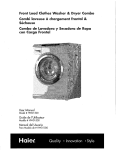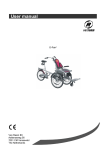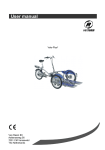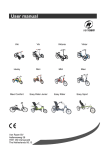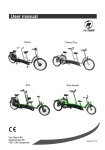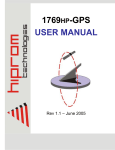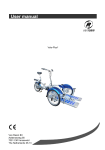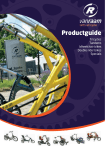Download OlympicHopper wheelchair manual
Transcript
Contents Foreword 2 Product description 3 Technical specifications 5 Safety instructions 6 Settings and adjustments 8 Use 12 Folding up the wheelchair 13 Transportation 14 Maintenance 15 Warranty 17 Details subject to change. The information in this manual is based on the technical specifications which applied to wheelchairs at the time of printing. Since that time, technical modifications may have been made to the wheelchairs other than those listed in the manual. 2013-06 version 2 Foreword The OlympicHopper is a sporty, contemporary wheelchair with an attractive curved aluminium frame. For the independent user who leads an active and energetic life, this organically designed wheelchair offers a large number of settings allowing a high degree of seating comfort and excellent riding characteristics. The OlympicHopper is intended for anyone with a disability who wants to pursue an active life. The OlympicHopper encourages the optimum possible sitting position for wheelchair users with a neurological condition, any type of paralysis, age-related restricted mobility, increased levels of pain, damage to joints and limbs or amputations. The user can find an ideal balance between manoeuvrability and stability by the infinite adjustment of the RCA*-Seat-System in relation to the rear wheels. The comfort of the ergonomically curved seat frame is increased by the additional backrest angle adjustment, which may be adjusted during use to change the sitting position as required. The OlympicHopper is splash proof and suitable for everyday use, both indoors and outdoors. The OlympicHopper is not O4 Wheelchairs Markenweg 9 designed as a sports wheelchair. Depending on the model, the maximum weight of the occupant is 120 kg. This is shown on the CE sticker. 7051 HS Varsseveld The Netherlands Tel.: +31 315 396 900 Fax: +31 315 396 909 [email protected] By complying with European standards BS EN 12182, BS EN 12183, BS EN 1041 and ISO 7176-15, the OlympicHopper is deemed to meet the essential requirements for medical devices in accordance with 93/42/ EEC. The wheelchair has been found to be crash test safe and meets the requirements of ISO 7176-19 for transport in, for instance, minibus taxis, with the occupant sitting in the wheelchair that is restrained in the vehicle. Please note Sections which are important for your safety are marked in the text with a safety symbol. Tip For tips and tricks, please consult www.o4.eu under Comfortably mobile. * RCA: Remote Continuously Adjustable GB 2 Product description 5 6 Check the items supplied Before you begin using the wheelchair, check that the items supplied match the product description below. If you believe that the product has been damaged during transportation, please notify your supplier. We are sure that the OlympicHopper will meet all your expectations and we hope you will enjoy using it. 1 2 3 7 4 OlympicHopper 1 2 3 4 5 6 OlympicHopper 1. Wheel lock (optional) 2. Anti-tip wheels 3. Frame 4. Front castor with swivel fork 5. Rear wheel 6. Pressure brakes 7. Footrest RCA-Seat-System 1. Push handle (integrated) 2. Backrest 3. Seat 4. Side panel 5. P ositioning component for setting the seat height, sitting angle and wheel balance (the “Interface”) 6. Control bracket for adjusting the backrest RCA-Seat-System These instructions describe the standard products (unless explicitly stated otherwise). There are obviously many other possibilities; these are listed under options and accessories (see page 4). GB 3 Product description Options Various options are available for both the OlympicHopper and the RCA-Seat-System: • (Detachable) rear wheel with standing lock • Footplate with heel guard and slots for foot loop • Folding footrest Accessories • Side panel with splash guard / armrests • Sitting position belt (for an extra stable sitting position) Utilisation The wheelchair is delivered by your dealer ready for use. Remove any protective foil from the push-rims of the wheels. GB 4 Technical specifications RCA-Seat-System • Seat width (C) (29 / 31,5) / 34 / 36.5 / 39 / 41.5 / 44 / 46.5 / 49 / 51.5 / (54 / 56,5 / 59) cm • Seat depth (A) (37,5) / 40 / 42.5 / 45 / 47.5 / 50 cm • Seat height front (F) 45 – 62 (50 – 52) cm • Seat height rear (G) 43 – 61 (47 – 49) cm • Back height (B) 35 / 40 / 45 / 50 cm • Backrest range 90° – 115° +10˚ (transport) A B Carrier • Inclination of wheels 3° (each side) RCA-Seat-System C D OlympicHopper RCA-Seat-System E HD F Inclination of wheels • Variants: -V arious wheel combinations (standard 24” rear and 5” front with 5” fork) - 2 Frame lengths: type 34 and 40 - Leg rest on front: type U, V8 and V16 • Length (E) 80.5 / 86.5 cm • Width (D) = Sitting width (C) + 17.5 cm • Maximum weight of occupant = 120 kg •T otal running weight of OlympicHopper with RCASeat-System (for example: type 44 - 42.5 - 40 = 16 kg) G OlympicHopper RCA-Seat-System GB 5 Safety instructions Assembly and adjustments • Before using the wheelchair, check that the removable parts (wheels, armrests and footrests) have been securely attached. Sitting in the wheelchair Caution: make sure that your fingers do not become trapped between the frame and the wheels or between the spokes of the wheels. The occupant or the attendant must be alert for this in the following cases: •If the wheelchair is tilted far backwards. •If the occupant is sitting lopsidedly in the wheelchair. •If the occupant’s arms are hanging limply over the armrest. •In any combination of the above situations. Riding in the wheelchair Caution: when riding on a slope, the centre of gravity will change and the wheelchair can easily tip backwards. Always make sure that the anti-tip wheels are properly adjusted (see also the warning sticker on the frame tube). Caution: contact between your calves and the red control bracket under the seat may disconnect the backrest. If possible, use a calf strap or heel strap. •When propelling the chair manually, take care of your hands if there is not much clearance to the left and right of the chair. •The wheelchair must never be left on a slope with the brakes off. •Put the wheelchair’s brakes on before getting into or out of the wheelchair or undertaking a transfer. •Use the wheel lock only to lock the rear wheels when they are motionless. The wheel lock cannot be used to slow down the wheelchair. Transporting the wheelchair •The OlympicHopper is suitable for transporting the user in a minibus taxi. GB 6 Safety instructions Environmental factors Environmental factors such as temperature and humidity may damage the wheelchair. The manufacturer advises that the OlympicHopper should be used in ambient temperatures between -15°C and +40°C. Caution: prolonged exposure to the sun may cause parts of the wheelchair to become hot. Be aware of this! Slopes and other obstacles •Always make sure that the anti-tip wheels are properly adjusted (the default setting is for the castor wheel to be 9 cm above the ground when the anti-tip wheel is on the ground). •The wheelchair is more likely to tip over on a slope than on a level surface. •Never tackle obstacles higher than 10 cm on your own. In general, only skilled users, who have sufficient strength, are capable of tackling obstacles up to 10 cm. •Always go off a kerb backwards to prevent the wheelchair from tipping forwards causing you to fall out of it. • Never go down stairs in the wheelchair alone. •Ask somebody to help you if you are not sure whether you can reach the top of the slope by yourself. •Never go up or down a slope with a gradient of more than 5°. •Going up a slope: lean your upper body forwards and move the backrest to the front. This reduces the risk of tipping backwards. •Going down a slope: lean your upper body backwards and move the backrest to the rear. This reduces the risk of tipping forwards. •Do not turn the wheelchair round on a steep slope. When the wheel chair is positioned across a steep slope, there is a high risk of tipping. • Always keep your speed under control when going downhill. •Slow the wheelchair down using your hands on the handrims only. Never use the wheel lock. Otherwise, there is a risk that you will lose control of the wheelchair. •Do not remove the anti-tip wheels, on account of the active adjustment of the OlympicHopper. For more information on safe riding in a wheelchair, please consult www.o4.eu under Comfortably mobile. GB 7 Settings and adjustments RCA-Seat-System Setting the seat height 1. Loosen the Allen screws (A and B) a little on both sides. First adjust the height of the front. 2. Remove the Allen screws B on both sides. 3. Set the desired seat height (front). 4. Insert and hand-tighten the Allen screws B on both sides. Then adjust the height of the back. 5. Repeat steps 2 to 4, but for the Allen screws A on both sides. 6. Finally, fully tighten all the screws. A Setting the seat height, sitting angle and riding characteristics Setting the sitting angle You can set the sitting angle to various positions. 1. Loosen the Allen screws (A and B) a little on both sides. 2. If the seat height is set correctly at the front, remove Allen screws A. If you want to change the seat height at the front, remove Allen screws B. 3. Set the desired sitting angle. 4. Place and insert the Allen screws. If necessary, readjust the wheel balance.* 5. Finally, fully tighten all the screws. Changing the sitting angle moves the centre of gravity with respect to the rear wheels. *Wheel balance • Loosen the Allen screws (A and B) on both sides. • Slide the RCA-Seat-System forwards (more stable) or backwards (more manoeuvrable and agile). • Retighten the Allen screws. Caution: when adjusting the wheel balance, too much rear wheel pressure increases the risk of tipping backwards. GB 8 B Settings and adjustments Adjusting the backrest angle The backrest angle is adjustable and may be adjusted during use. 1. Relieve the tension on the backrest by reducing the pressure on it a little. Lift the red control bracket under the seat. 2. Set the desired backrest angle. 3. Release the red control bracket. When pressure is placed on the backrest, a clicking sound may be heard. Tips: •S elect a larger backrest angle in places with a high rolling resistance; this makes riding easier. •W hen ascending a slope, select a smaller backrest angle. Adjusting the backrest angle GB 9 Settings and adjustments OlympicHopper Setting the lower leg length The sitting angle and seat height must be set before you can set the lower leg length. 1. Loosen the Allen screw (A) and nut on the footrest. 2. Set the desired lower leg length. aution: observe a minimum safety distance C of 6 cm from the ground. Setting the lower leg length 3. Tighten the Allen screw again. Adjusting the anti-tip wheels The anti-tip wheels can be adjusted and/or retracted using the pull knob. 1. Pull out the knob and turn it a quarter of a turn. 2. Set the desired height from the ground (the default setting is for the castor wheel to be 9 cm above the ground when the anti-tip wheel is on the ground). Listen for the ‘click’. 3. Turn the knob a quarter of a turn back and release it. 4. Check that the anti-tip wheel is fixed. Adjusting the anti-tip wheels Wheel lock (optional) The wheel lock is located in the hub of the handrim wheel. Rotate the lever to lock the wheel. Disengage the brake on the wheel before removing or replacing the rear wheel. Hub brake GB 10 Settings and adjustments Inflating the tyres The tyres can be inflated to the correct pressure using a tyre pump suitable for a car tyre valve. An adapter is required to do this. The tyres may also be inflated using a high-pressure (bicycle) pump. The correct tyre pressure is shown on the tyres (6 – 10 bar). To ensure comfortable riding in the wheelchair, i.e. with the lowest possible rolling and rotational resistance, it is important that the tyres have the correct pressure. The wheelchair will be more difficult to propel and manoeuvre if the tyre pressure is too low. Advice To safeguard the warranty and to ensure your safety, the manu facturer recommends that the settings should be carried out by your supplier. GB 11 Use Getting into and out of the wheelchair independently Caution: put the brakes on before getting into and out of the wheelchair. If applicable, remove the side panels and armrests before getting in or out. How an attendant should tackle obstacles 1. Push the handles down. 2. Push the wheelchair onto the obstacle. 3. Push the wheelchair further and lift the rear wheels over the obstacle with the handles. Stairs It is better to ascend a kerb forwards, it is better to descend a kerb backwards. Kerb Caution: when descending a slope, keep the speed under control. Before tackling obstacles independently, the manufacturer recommends that you should first practise extensively under the supervision of a therapist. For tips and tricks, please consult www. o4.eu under Comfortably mobile. Slope Caution: when riding on a slope or uneven terrain (for example forest paths), the centre of gravity will change and the wheelchair can easily tip backwards. The wheelchair is equipped with anti-tip wheels. These should never be removed and should always be adjusted according to the type of use. Less experienced users can adjust the wheelchair to less active settings. This means that more effort is required to propel the wheelchair, but it is also more stable. GB 12 Folding up the wheelchair Folding up the wheelchair You can remove the wheels. Disengage the brake on the rear wheel. Press the axle button with your thumb and pull the wheel and axle out of the frame. Keep the axle button pressed in while doing this. Removing a wheel In combination with the RCA-Seat-System, the backrest can be folded forwards onto the seat (see page 9, adjusting the backrest angle). You can also retract the anti-tip wheels (see page 10, adjusting the anti-tip wheels). After folding up the wheelchair, all the components can be transported separately. Folding up the wheelchair Caution: make sure that your fingers do not become trapped between the separate components. It is advisable to lift the wheel by the push-rim. GB 13 Transport Transport The OlympicHopper has been found to be crash test safe and meets the requirements of ISO 7176-19 for transport in, for instance, minibus taxis, with the occupant sitting in the wheelchair that is restrained in the vehicle. The manufacturer advises the occupant to transfer to a fixed seat. In its folded state, the OlympicHopper can be transported in the boot or on a passenger seat of a car (see page 13). The anti-tip wheels can be adjusted and/or retracted using the pull knob, for example for transportation. Retracting the anti-tip wheels makes the wheelchair compact, for example for being transported in a car. Caution: retracting the anti-tip wheels may give rise to dangerous situations if the user forgets to extend them again when making the wheelchair ready for use. GB 14 Maintenance Cleaning Regularly clean your wheelchair with a damp cloth, water and a multipurpose detergent. The upholstery of the backrest and seat can be washed using a mild detergent at 30° C. Reuse (dealer information) The wheelchair is suitable for reuse. To ensure safe reuse, the new user should be offered all the required support and technical information that guarantees safe use. The wheelchair must be cleaned and disinfected in accordance with the maintenance instructions and tested and released for use by an authorised dealer. Caution: never use aggressive cleaners or solvents such as thinner, benzine or the like. Consult your supplier for information about disinfecting your wheelchair. Routine maintenance (every two weeks) You can carry out routine maintenance to the OlympicHopper yourself. Check the tyre pressure. Soft tyres result in heavier riding characteristics on account of the increased rolling and rotational resistance. Check that all attachments and accessories are securely in place. If necessary, tighten them with an appropriate Allen key. Caution: over-tightening the screws may damage the wheelchair. Annual maintenance Your supplier will be pleased to carry out the annual maintenance of your wheelchair. In this way, you can be sure that your wheelchair is in optimum condition. Please also contact your supplier for the replacement of parts. There is no service manual available for the OlympicHopper. Repairs In the unlikely event of technical problems with your wheelchair, we advise you to immediately contact your supplier. The supplier will assess whether he can repair the wheelchair or whether it needs to be returned to the manufacturer for repair. GB 15 Maintenance Caution: inexpert repairs may lead to injury. In addition, the product warranty will be invalidated. Use common sense and consider whether you are capable of resolving technical problems with the wheelchair yourself. If in doubt, always consult your supplier. Always adhere to this manual and your supplier’s advice when adjusting and (dis)assembling parts. Avoid all dangerous situations for the occupant of the wheelchair (and attendant, if applicable)! GB 16 Warranty The OlympicHopper is guaranteed to be free from frame breakage for a period of 2 years. The obligation of the manufacturer under this warranty is limited to the repair or replacement of parts. The warranty does not in any case cover defects arising as a result of: non-compliance with operating or maintenance instructions, non-standard use, normal wear and tear, negligence, overloading, accidents caused by third parties, the use of non-original parts or defects of which the cause is located outside the product. This warranty supersedes any other warranties: laid down by law, or communicated verbally, except that which is warranted by the manufacturer in writing. Warranties are valid exclusively within the EU. You can inspect or download the general and delivery conditions of O4 Wheelchairs on our website: www.O4.eu GB 17 GB 16 GB 17 GB 18





















